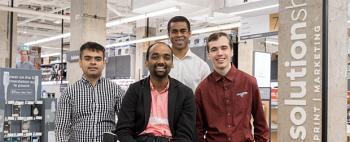Toronto startup helps disabled and their communities with VR
When SenseTech Solutions recently won Staples’ This is How I Grow My Business contest, the team of four recent engineering graduates found their altruistic approach affirmed. The start-up that designs accessible virtual reality and augmented reality simulations for individuals with disabilities were getting recognized for both their tech-savvy and compassion for research.
But their work has already made an impact across the country, according to chief executive officer Robert Ingino told IT Business Canada.
He provided some examples including some of the work they do with the Canadian National Institute for the Blind (CNIB).
“We can simulate how it is to have a condition like glaucoma, cataracts and other problems. We can also help people who want to come and see how it is to have these issues,” he said, adding there’s more empathy for charities than if people just put on a blindfold during a visit.
One of the big differences with this VR technology, he explained, is empathy. The disabled person and members of their support system can experience the same stimulus. In one scenario, it gives parents and/or helpers a better idea of what their disabled child might need to go through in a public classroom setting.
“A whole audience can get a new awareness about disabilities,” said Ingino.
Here’s how the technology works
There’s a head-mounted display option and projector VR option that surrounds someone or a group with three projectors. These are between eight and nine feet tall for an immersive experience.
The projector VR ‘rooms’ are designed for a group of people which could include instructors. It works a lot like a virtual reality cinema.
SenseTech’s founders, who include Rijul Aggarwal, Rui Amoah and Ali Raza Syed, wanted to get everyone who supports a disabled person involved.
Training and rehabilitation
There’s also training and rehabilitation angles to the services SenseTech provides. They’re part of a three-step process that includes their VR tools. The end goal is allowing disabled people to get more independence.
Ingino said the first phase involves someone with a disability coming into a hub, service centre or clinic.
“They would use our virtual reality training to help them get rid of some of the fears they have of going into the actual environment.”
Sound and visual cues
One of the biggest barriers people with sound or visual impairments have is getting used to a new environment. The startup leaned on sound and visual cues to get those people used to a corresponding environment in the real world. They move into the actual space next with an instructor on the path to their independence.
These new tools are designed to help a wide swath of disabled people. Both young and older folks need what Ingino calls a “VR safe environment” to overcome their fears about transitioning into real-world situations.
Ingino used the example of a child with a vision disability who wants to attend regular school. With SenseTech technology they can simulate that environment and proactively work on any challenges.
The Bottom Up
“We always try to start from the bottom up,” said Ingino. “ Because the people who know the most about the problems inside the community for a disability are the folks helping day to day.”
The team plans on moving across Canada to help those with disabilities or health issues. That humanitarian approach has caught the eye of charities and influential business people at the same time.
The SenseTech team is currently being mentored by Champion of Entrepreneurs, Joe Mimran.





